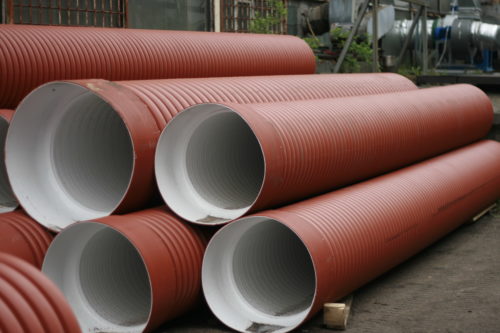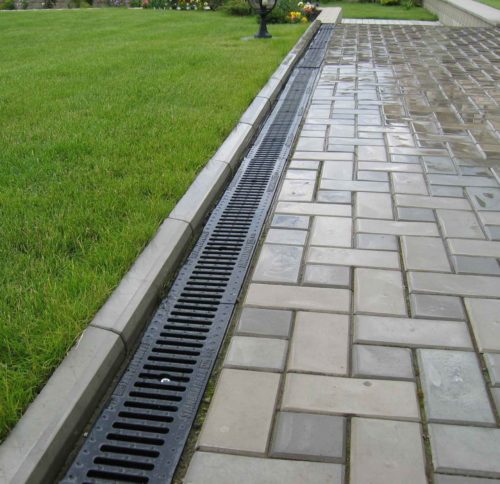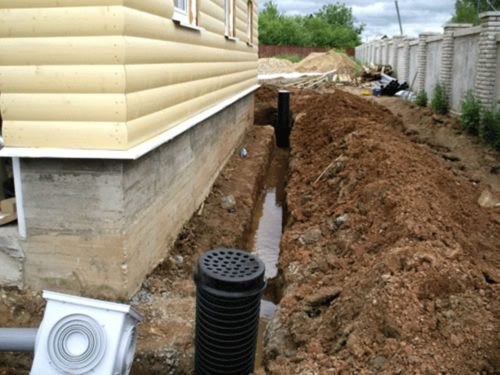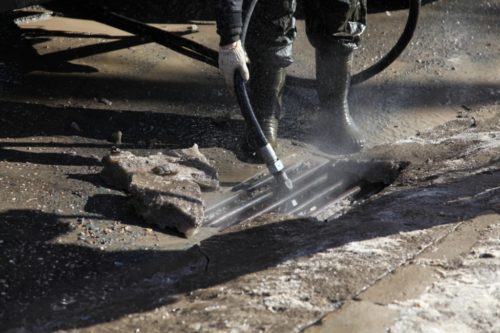A large amount of moisture on the country site may cause a fearing when melting snow in spring and prolonged rainstone rains. Even worse when water accumulates near the house. This can lead to the destruction of the foundation of the building. You can get rid of this problem by means of a storm sewage device.
Content
Storm sewage in a private house with their own hands. Elements of the drainage system
Immediately it is necessary to mention the fact that Livnevka consists of. Its main elements are:
- pipes;
- viewing wells;
- chute;
- rain-seekers;
- sandowellands.
Pipes are waterproofs intended for moving water to the collector. When designing a storm outlet, the pipe laying can be carried out in two ways:
- close to the surface (when the system will be used only in the summer);
- deep in the ground (with year-round use of water removal).
When choosing a cross section of pipes, the amount of precipitation in the region is taken into account. With a predominance of wet weather, it is impossible to mount too narrow pipes, because they will not be able to effectively remove water.
Installation of viewing wells is made in places of turns of pipes and every 25 m. The main function of the structure is to inspect the drainage on the subject of pollution and their cleaning.
Installation of the grooves is needed in places where there are large mechanical loads. For example, near the garage or parking lot. The gutter is made of various materials: concrete, polymer concrete, plastic. The kit to the grooves sometimes includes metal nozzles with a grid that does not allow large garbage.
Ranaremics are installed under drainage pipes and on a platform that has a impermeable coating. We are usually produced from plastic. The set to rainmakers may include garbage basket, a cast iron or galvanized grille and partition.
Sandowners are a filtering element. Thanks to their installation, the drainage system will not block the soil particles, sand and small garbage.
If there is a well-drink well in the country territory, then to prevent its pollution, it is recommended to use additional filters and an UV block of disinfecting of wastewater.
The advantages of the storm drainage include:
- ease of installation;
- attractive appearance;
- minimal impairment of soil;
- lack of system maintenance costs;
- long operational period.
Main criteria for storm sewage device
There are no special requirements for the installation of landing. The main one is presented to the depth of the pipe laying. When the diameter of pipes up to 0.5 m, the depth of the drainage laying should be within 35-50 cm. Laying of wider tubes is carried out at a depth of 70-90 cm.
The second inherent condition for the quality drainage of the site is the right choice of pipes. Due to the fact that the removal of water occurs in gravity, the special requirements for pipes for pressure resistance are not presented.
Pipes intended for storm drainage should be characterized by:
- frost resistance;
- resistant to chemical medium and corrosion;
- as a smooth surface (dirt should not linger and accumulate on a certain area);
- normal bandwidth.
Such pipes are suitable for storm sewage:
- cast-iron;
- asbestos-cement;
- plastic.
Cast iron products are applied for quite some time. They differ in durability and durability. But, on the other hand, the pipes have a very large weight (this makes it difficult to the process of installation), the high-cost and rough inner surface.
The characteristic positive features of asbestos-cement pipes are a smooth inner surface, corrosion's inconsistency and a long-term operational period. The disadvantages of products include heavy weight, the probability of breaking with a strong impact and the complexity of the docking of adjacent pipes.
Plastic pipes are the perfect option for the drainage of the site. The maximum possible service life (over 50 years), light weight, affordable price and simplicity of installation work are characteristic of plastic products. With a drainage device, a depth of more than 5 m is better to use two-layer corrugated pipes.
For the removal of water from home and in the country territory, pipes from metal plastic and fiberglass are still suitable. But their installation refers to too costly technology.
The procedure for calculating the maximum volume of incoming water includes the definition and multiplication of the following indicators:
- the intensity of precipitation (it can be found in the meteorological service);
- the area of \u200b\u200bthe roof or the entire site;
- the coefficient of absorption moisture surface (roofing - 1.0; asphalt concrete - 0.95; concrete - 0.85; rubble - 0.4).
Based on the water volume indicator, the optimal diameter of pipes for the storm sewering of the house is determined:
- up to 10 - pipes with a diameter of 10 cm are used;
- 10-30 - 15 cm;
- over 30 - 20 cm.
Storm sewage in a private house. Types of storm drainage
The drainage system is classified depending on:
- way of removal of water;
- type of drainage.
According to the first criterion, the sewage is:
- outdoor (superficial);
- internal (deep);
- combined.
Surface drainage is the easiest and most common option. Usually used with drainage device near tracks. The drop-down sediments fall into trays that are mounted in the dials under the tilt to the collector and closed with lattices. The outer mountaineering more acts as a decorative element.
Deep drainage is a more complex building. He involves digging trenches, laying pipes and installation of viewing wells. But it is precisely such a drainage that has maximum efficiency.
Combined Livnevka provides for the use of both the above-mentioned types of drainage, based on the amount of water on a specific area.
Depending on the type of drainage, the storm sewage is divided into:
- Point. Ranges are mounted in places with the largest moisture accumulation. All rain-seekers are connected using pipes into a single system.
- Linear. This technology is used with drainage devices in a large area.
Installation of storm sewage
At the preparatory stage is made to dig trenches for laying pipes. Trenches should be sled under a slope with a subsequent tamper. The bias is needed for faster water under the pipes. Otherwise, in the winter period, flowing water can freeze and prevent efficient drainage.
The magnitude of the slope directly depends on the diameter of the pipes. When using a material with a minimum diameter, the slope should be in the range of 0.3-0.6 cm / m. When wider pipes are used, the bias can be within 1-2 cm / m.
At the venues and broad tracks, holes are made to rain-seekers, which should be located at the lowest points of the site. The places of contact with the coated rain-seekers are subject to sealing. To do this, you can use bitumen.
The installation of grooves and waterproof pipes on the roof with the assembly of the water discharge assembly in trays is made. The drains themselves must be attached to the wall of the clamps.
After the device of the ground part in the trenches, pipes are stacked. Trays and gutters taking water are mounted in shallow trenches (no more than 50 cm). Setting sandwalkers is carried out in places where pipes are connected to the gutters.
Useful recommendations on installation:
- To facilitate the device of the slope and high-quality laying of pipes, use the sand from which the pillow is made up to 15 cm thick.
- It is necessary to avoid turns of pipes. If there is no such possibility, then viewing wells are mounted in places of pipes.
- Pipes and viewing wells are mounted on the depth below the soil freezing point. Otherwise, they need to be insulated.
- After installation, the drainage system is inspected by abundant irrigation. The revealed shortcomings are eliminated, the gutters and trays are closed with lattices, the pipes in the trenches are covered by the earth.
Cleaning Livnevka from blocks
Finally, how to clean the storm sewer. This procedure will help to avoid serious system blockages. Preventive work is recommended to be carried out 2 times a year: late in winter (before melting of snow) and in the fall (before snow dropping).
In the presence of sites and tracks laid out of paving slabs, the probability of blocking increases. This is due to the fact that the sand is blurred and easily enters drainage. For this reason, it is necessary to withdraw more often and clean the removable trash of sandwalkers.
There are the following methods for cleaning the storm sewage:
- mechanical;
- hydrodynamic;
- thermal;
- chemical.
Mechanical drainage cleaning is carried out using a metal cable. The destruction of a strong blockage occurs a sharp tip of the cable. You can use both manual fixture with a turntable and an electric drum-type mechanism.
The hydrodynamic method is a water jet that is fed under high pressure. Pump installations are equipped with special nozzles that are placed in drainage pipes. Of course, you can take advantage of the canal locomotive machine. But this is allowed only in the absence of a tap line.
The thermal method is similar to the hydrodynamic clearance of the lavety. The only difference is the use of hot water and steam. Thermal cleaning is used when blocking pipes with a dense substance. The procedure is made by a special apparatus that will have to be leased.
Chemical cleaning involves the use of funds that are submitted to the drainage system under pressure. As a result, a thick foam is formed, destroying the blockage. After this pipe is washed with cold water. It is not recommended too often to use this method of cleaning pipes. Since it is fraught with environmental pollution.
Video on the installation of the stormwater removal system:

























